2 Apr 2012
Last month we opened applications for the David Miller Travel Bursary offering travel grants of £250 to students wanting to travel to enhance their studies. The first applications have already been received although the closing date of 14 May is still some way off. Please encourage any students who might be eligible to consider applying. Details
In collaboration with 'Fascination of Plants Day' in May we are organising a visit to Thanet Earth on Wednesday 16 May. This will be an opportunity to see the UK's largest and most high-tech greenhouse complex.
The Professional Horticulture Group South West are organising a visit on 25 April in conjunction with SCI Horticulture Group to Jekka's Herb Farm which hold the UK's largest collection of herbs, followed by a visit to Pan Global Plants, a nursery specialising in the introduction of new plant species especially hydrangeas, magnolias and bamboos. Full details of both visits will be published on the website shortly.
Further discussions have taken place with Grow Careers as a result of which we have agreed to take the lead in developing the 'Plant Science and Technology' section of its website in order to bring in the diverse range of careers in allied science industries which are directly related to the horticulture industry.
Editor
Caveat emptor (buyer beware!)

Most noticeable is the tall bamboo, which grows along most roadsides. Ghana has an integrated programme to promote the use of bamboo and rattan. There's a Bamboo and Rattan Development Programme (BARADEP) and an NGO, Bamboo and Rattan Network of Ghana (BARNET). I wasn't aware of either the programme or organisation when I visited two years ago. What struck me forcibly was the use of bamboo stems as supporters for television aerials. Drive through any village, and you notice that each single-storey house has a tall bamboo stem topped with an aerial next to it.
Another softwood species is used for crafting tourist artefacts such as fans. It's feather-light; reminiscent of the balsa-wood aeroplane kits that one's brother used to build, using the kind of glue best given plenty of airspace.
At Boabeng-Fiema in central Ghana, we stopped to visit the sanctuary, where friendly mona monkeys and shy colobus are revered by local villagers. There's a graveyard for monkeys dating back at least to 1831. We walked in the company of Mr Albert, and watched colubus monkeys fly ahead of us through the hardwood canopy, and the monas boldly visiting village huts for food.
The sanctuary boasts a craft centre, stocked with a range of carvings, images and the like. Most welcome on a hot afternoon were the fans, with a central light wooden head and handle, the head supporting a semi-circular 'hair-do', woven of grass dyed in the Ghanaian red, yellow and green (pictured upper right). Attractive and efficacious.
The fan travelled home with me, and perched on the top of my fridge - a reminder of warmer times in the aftermath of a harsh English winter. A few months later, I saw to my horror that the carved eye in its head had a hole in it (lower right). Anyone who's watched From Russia with Love will remember the wall-size poster of Anita Ekberg, with an escape route opening out of her mouth. Similar effect, but scarier.
I spotted the rear end of a beetle poking out, and dripped methylated spirits into the hole till the wriggling stopped. In the next six months, two more beetles hatched, each arrival signalled by a little heap of wood-dust. I hope both insects died happy in a drunken stupor. Number three fell out, revealing itself as a centimetre-long beetle.
It's two years now since the fatal fan reached these shores. My house is still standing, its woodwork seems to be intact. I don't feel the need to turn myself, or my fan, in to DEFRA. But if anyone else has experiences to share or advice to offer, please get in touch.
Margaret Waddy
Plant of the Month
Doronicum orientale, leopard's bane, Asteraceae
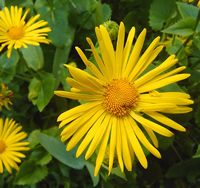
There are around 40 different species of Doronicum, all from temperate climes across Eurasia and the Mediterranean. ' There are several species in the horticultural trade as well as hybrids and cultivars. The RHS plant finder lists the cultivar 'Miss Mason' as the only worthy of an AGM (Award of Garden Merit) but with no current suppliers listed. Doronicum orientale 'Magnificum' appears to be the most popular with nurseries.
The common name of leopard's bane refers to any plant of the genus Doronicum and indicates that this genus was once considered useful in destroying and warding off wild beasts! Now there's a useful garden plant.
Alison Foster
Oxford Botanic Garden
Medicinal Plant of the Month
Acmella oleracea, toothache plant, Asteraceae
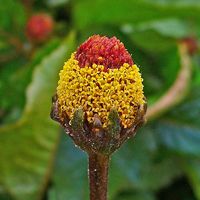
Dr Francoise Barbira-Freedman, medical anthropologist from the University of Cambridge was give some of this plant to chew whilst living with the Quecha Lamas community in Amazonian Peru. In 2004 she brought some of the plant back to the UK for a neuropharmacologist colleague who has since tested the plant and is now developing a local anaesthetic from it.
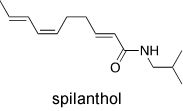
Despite the tingling sensation it produces the leaves can be eaten as a salad vegetable, in fact the specific epithet (oleracea) means that the plant is of the vegetable garden! (Brassica oleracea sound familiar?)
Alison Foster
Oxford Botanic Garden
Horticulture Industry News
For the very latest horticultural news follow us on Facebook and or
Twitter.
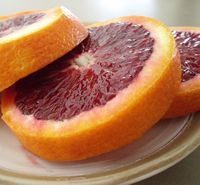
Nutritional research shows that juice from blood oranges gives additional health benefits compared with ordinary 'blond' orange juice. The fruit's health benefits come from the natural anti-oxidant anthocyanins that give the 'blood' colour. Scientists at the John Innes Centre in Norwich have identified the gene responsible for producing anthocyanin pigmentation - which they call Ruby - and worked out how it is switched on.
Unfortunately the Ruby gene is controlled by genetic switches that are activated by cold stress so blood oranges can only be grown reliably on a commercial scale in eastern Sicily. Their results offer little hope of conventionally breeding or identifying new varieties of blood orange that are free from cold dependency, so they are now experimenting with hooking the Ruby gene up with a specific fruit [gene] promoter so it can be induced in another way. Some experimental GM orange seedlings, with the Ruby gene activated in this way, are growing near Valencia in Spain but they are still too young to bear fruit.
If new fruit varieties capable of turning red in any weather can be commercialised, then the world's citrus farmers will be able to produce far greater volumes of healthy blood orange juice. More
Plants are affected by noise
A US team has found that industrial noise disrupted the behaviour of animals that pollinate plants and disperse seeds and could be slowly transforming our landscape, especially by changing the dispersal of slow-growing trees. In one of their experiments they found that the black-chinned hummingbird (Archilochus alexandri ) preferred to visit and thus pollinate flowers in noisy sites probably because their predators avoided the noise. In a second experiment they found that mice preferred to eat seeds scattered at noisy sites again because their predators avoided the noise. More
Temperature 'switch' for flowering
Researchers have identified the genetic 'switch' that triggers the flowering process in plants as they respond to warmer temperatures. They found that a gene, known as PIF4, activated the flowering pathway when a certain temperature was achieved. The team added that the findings could be used in future research to improve crops' resilience to projected changes in the climate. More
Far-out photosynthesis
Most plants photosynthesise using chlorophyll a, which uses light photons between 400-700nm. In 1996 a cyanobacterium, Acaryochloris marina was discovered that photosythesises using chlorophyll d, which uses lower energy photons up to 740nm in the near infra-red. Work has now shown that A. marina photosynthesises as efficiently at these long wavelengths as other cyanobacteria that utilise chlorophyll a. More
Research aims for summer production in Almeria
In summer, all horticultural production ceases in the greenhouses of Almería. In spring the horticultural campaign ends and watermelons and melons take the place of tomatoes and peppers. But this calendar could change soon. A project carried out by five companies, suppliers of horticultural technology, with a total investment of €6m - €2m of which is public money - aims at developing new types of greenhouses that could produce vegetables throughout the year. Even during the summer months, when the heat forces the facilities idle.
The project named 'Humidex' aims at controlling humidity and other physical and biological parameters within the houses, in order to extend the production cycle to twelve months. 'We aim to break the seasonality of Almería between the months of May and October, because those are the months when we are absent and The Netherlands' produce reach the European markets' - says Lucas Galera, general manger of 'Novedades Agrícolas', a technology company leading the project.
Plants 'remember' drought
Plants subjected to a previous period of drought learn to deal with the stress thanks to their memories of the previous experience, research has found. The findings could lead to development of crops better able to withstand drought. The research also confirms, for the first time, the scientific basis for what home gardeners and nursery professionals have learned: transplants do better when water is withheld for a few days to drought-harden them before the move.
Working with Arabidopsis the team compared the reaction of plants that had been previously stressed by withholding water to those not previously stressed. The pre-stressed plants bounced back more quickly the next time they were dehydrated. Specifically, the non-trained plants wilted faster than trained plants and their leaves lost water at a faster rate than trained plants. More
Clock gene helps plants prepare for spring
Scientists have made fresh discoveries about the processes that govern plants' internal body clocks and help them adjust to changing seasons, triggering the arrival of flowers in spring. Researchers tested computer models of gene networks in a simple cress plant to determine the role played by a protein, known as TOC1, in governing these daily cycles. The model shows how 12 genes work together to run the plant's complex clockwork, and reset the clock at dawn and dusk each day.
Researchers found that the TOC1 protein, which was previously associated with helping plants to wake up, is in fact involved in dampening gene activity in the evening, helping them stay dormant at night. These findings contradict what scientists had previously understood about the gene and its role in early morning activity.
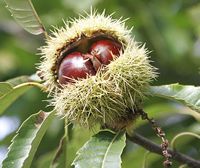
The Forestry Commission and The Food and Environment Research Agency (Fera) are working to eradicate outbreaks of a serious new disease affecting sweet chestnut trees in southern and central England. Chestnut blight, caused by the fungus Cryphonectria parasitica (C. parasitica), has been confirmed by Forestry Commission scientists in two small orchards of European sweet chestnut (Castanea sativa) sourced from the same nursery in France. The sites in Warwickshire and East Sussex are the first findings in Britain, although the disease has spread throughout much of Europe since it was first discovered in Italy in the 1930s.
Protein helps attract mycorrhiza to roots ...
About 80 percent of all terrestrial plants enter into a symbiotic relationship with fungi living in the soil. The formation of this symbiosis is a strictly regulated process that the plant activates in low nutrient levels. The roots release the hormone strigolactone, which is detected by the fungi. The fungal hyphae grow towards the roots, penetrate the epidermis and isolated passage cells, and enter the root cortex.
Exactly how strigolactones are released into the soil from the roots and how the fungi find the specialized entry points in the roots was not known until now. A research group using petunia as a model plant, was able to demonstrate that the protein PhPDR1 transports strigolactones. The protein belongs to the ABC-transporter family found in simple organisms like bacteria, but also in humans.
The researchers observed that PhPDR1 is expressed more highly in a low nutrient content in order to attract more symbiotic fungi, which then supply more nutrients. But there are also plants like the model plant Arabidopsis (mouse-ear cress) that do not form any mycorrhiza. If the researchers added PhPDR1, however, the Arabidopsis roots transported strigolactones again.
... but strigollactone has a dark side
As well as attracting beneficial mycorrhizal fungi, strigolactones also attract unwanted parasitic plants which weaken the plants. They also act as a plant hormone to suppress the outgrowth of branches in the leaf axils of the plants. Without strigolactones, plants would become bushy with excessive side-shoots. Tomato plants without this regulating hormone grow uncontrollably with dozens of unwanted side-shoots. Their growth 'steals' a great many nutrients from the fruit.
Over the years, work on improving crops has probably unconsciously been based on selecting species with high levels of strigolactones. This is because growers prefer varieties without branching. But it would now seem likely that species without side shoots have high strigolactone levels, a substantial amount of which penetrates the soil and causes more and more aggressive parasite seeds to germinate.
Although strigolactones stimulate the absorption of phosphates via mycorrhiza in poor-quality farming land, this does not always compensate for the damage caused by parasites.
News from our Associates

SCI Horticulture has agreed to take the lead in developing the 'Plant Science and Technology' section of the Grow Careers website in order to bring in the diverse range of careers in allied science industries which are directly related to the horticulture industry.
Society of Biology

The scrutiny provided by the House of Lords is extremely important and reducing the committee's output would diminish Parliament's ability to understand and respond to scientific advances. There is also great value in the longer timescale over which the House of Lords occasionally works and its different remit. To remove this function is extremely risky, especially at a time when so many non-departmental public bodies, advisory groups and departmental bodies are undergoing change.
Mark Downs FSB, Chief Executive of the Society of Biology, is very supportive of calling on the Government to retain the committee. He says: 'This committee has essential expertise that helps inform and advise Government and Parliament and ensures science is better represented in our country's policy development. To abolish it now with no proper review and alternatives in place would be a serious mistake.' More
eEvents Calendar
SCI Horticulture Group events are listed here
Other Events of Interest
Mechanical Harvesting & Handling Systems of Fruits and Nuts
2 - 4 Apr, International Society for Horticultural Science
Lake Alfred, USA
Valuing Ecosystems: policy, economic and management interactions
3 - 4 Apr, James Hutton Institute
Edinburgh, UK
Symposium on Artichoke, Cardoon and their wild relatives
10 - 13 Apr, International Society for Horticultural Science
Viterbo, Italy
Effective application: exploring synergy between Agricultural Economics and Applied Biology
16 - 18 Apr, Association of Applied Biologists
Warwick, UK
Registration of Agrochemicals
17 - 18 Apr,
Brussels, Belgium
UK Plant Science
18 - 19 Apr, UK Plant Science Federation
Norwich, UK
Valuing Trees & Woodlands - a new understanding of their true worth
23 Apr, Institute of Chartered Foresters
Stoneleigh, UK
Symposium on Guava and Other Myrtaceae
23 - 25 April, International Society for Horticultural Science
Petrolina, Brazil
Protea Research Symposium
23 - 26 Apr, International Protea Association and International Society for Horticultural Science
Santiago, Chile
Insect Decline; The causes and the Role of Agriculture in Mitigation
25 Apr, SCI and Association of Applied Biologists
Harpenden, UK
History Comes to Life: Seventeenth-Century Natural History, Medicine and the 'New Science'
27 Apr, Society of Biology
London, UK
Biotechnology and other Omics in Vegetable Science
29 Apr - 2 May, International Society for Horticultural Science
Antalya, Turkey
Society of Biology AGM
3 May, Society of Biology
London, UK
Desert Green
7 - 9 May, Unido, UNDP, FAO
Qatar
Plasticulture for a Green Planet
15 - 17 May, International Society for Horticultural Science
Tel Aviv, Israel
Harnessing Emerging Technologies for Environmental Science
16 May, Environmental Virtual Observatory
London, UK
International Blackcurrant Conference
16 - 18 May, James Hutton Institute
Dundee, UK
Edible Alliaceae
16 - 19 May, International Society for Horticultural Science
Fukuoka, Japan
Mineral Nutrition of Fruit Crops
19 - 25 May, International Society for Horticultural Science
Chanthaburi, Thailand
Plum and Prune Genetics, Breeding and Technology
20 - 25 May, International Society for Horticultural Science
Davis, USA
Soilless Culture
22 - 25 May, International Society for Horticultural Science
Shanghai, China
European Botanic Gardens Congress
28 May - 2 Jun, Greek Botanic Gardens and The Hellenic Botanical Society
Chios, Greece
International Peat Congress
3 - 8 Jun, International Peat Society
Stockholm, Sweden
Processing Tomato
9 - 11 Jun, International Society for Horticultural Science
Beijing, China
New developments in food science: realising the potential of 'omics' technologies
13 Jun, Food and Environment Research Agency and The Joint Institute for Food Safety and Applied Nutrition
York, UK
The Arb Show
15 - 16 Jun, Arboricultural Association
Cirencester, UK
Vaccinium and Other Superfruits
17 - 22 Jun, International Society for Horticultural Science
Maastricht, The Netherlands
Tropical and Subtropical Fruits
18 - 22 Jun, International Society for Horticultural Science
Guangzhou, China
Organic Fruit Symposium
18 Jun - 21 Jun, International Society for Horticultural Science
Leavenworth, USA
The Landscaping Show
19 - 20 Jun, The British Association of Landscape Industries
Kenilworth, UK
Centenary of the founding of The Plant Breeding Institute, Cambridge
20 Jun, John Innes Institute
Norwich, UK
Biological control of fungal and bacterial plant pathogens
24 - 27 Jun, Envirochange
Reims, France
Virus Diseases of Ornamental Plants
24 - 29 Jun, International Society for Horticultural Science
Ski and Grimstad, Norway
Postharvest Symposium
25 - 29 Jun, International Society for Horticultural Science
Kuala Lumpur, Malaysia
National Plant Show
26 Jun - 27 Jun, Horticultural Trades Association
Kenilworth, UK
Roots to the Future
27 - 29 Jun, International Society of Root Research
Dundee, UK
Vineyard Mechanization and Grape and Wine Quality
27 - 29 Jun, International Society for Horticultural Science
Piacenza, Italy
If you would like to advertise a forthcoming event please contact charne.green@soci.org
Horticulture Group Contact Details
For submitting ideas or to volunteer to be part of a committee or a group, please contact:
Chairman - Peter Grimbly
Meetings Secretary - Alison Foster
Minutes Secretary - Margaret Waddy
Newsletter co-ordinator - Sue Grimbly scihortigroup@btinternet.com
Group Contact - Charne Green charne.green@soci.org T: +44 (0)20 7598 1594
